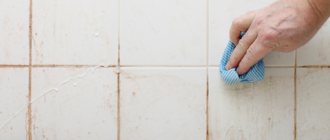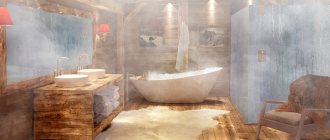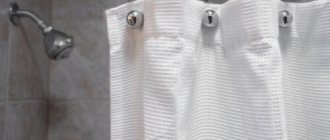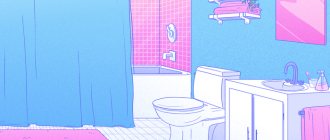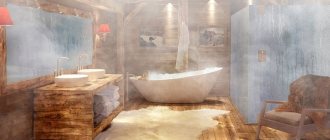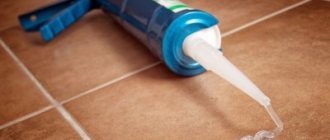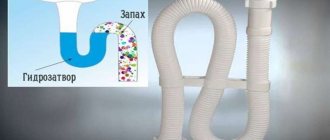Quite often you have to deal with such an unpleasant phenomenon as black spots on the ceiling in the bathroom - this is mold . In addition to spoiling the appearance of the room, mold is harmful to human health.
Its waste products are toxic and after inhalation, a person may develop allergic reactions and feel worse. Although it is difficult to fight mold, it must be done and it is possible to cope with it.
Dangers of each type
There are always mold spores in the air, but they begin to develop only under favorable conditions. It can appear on concrete, brick and other surfaces and be black, green or blue.
Types of mold:
- black mold , its type depends on the stage of development;
- white mold on walls is rare, it is often confused with efflorescence, but if you pick it up in your hands, it will knead and the efflorescence will crumble;
- blue , it affects wooden surfaces;
- actinomycetes are a cross between algae and fungi; they also infect wooden objects;
If we talk about a person’s reaction to mold, it can be divided into the following groups:
- Allergic , it is especially dangerous for people with diseases of the respiratory system and is often the cause of allergic rhinitis.
- Pathogenic , it can cause various diseases, healthy people with strong immunity usually cope with it, but children, the elderly and people with weak immunity can develop diseases such as pneumonia, bronchitis, etc. It forms gray and black colonies.
- Toxic species can cause serious complications, and even death. Problems caused by such mold can be in the form of irritation, other symptoms and even lead to the development of cancer.
Mold spores can enter the human body through the air, during breathing, through the skin or through food.
The most common diseases that arise from exposure to mold are asthma, pneumonia, other respiratory diseases, upset stomach, various skin rashes, and headaches.
With prolonged exposure to pathogenic species, a person may develop internal bleeding, kidney, liver, and lung diseases. When mold enters the human body, it is called mycosis; for diagnosis, it is necessary to contact a specialized laboratory.
General rules for antifungal treatment
A set of measures aimed at eliminating mold includes mechanical and chemical effects on the affected area. To eliminate it, you must follow the following recommendations:
- Use protective equipment when treating affected surfaces with special means (gloves, glasses, mask).
- Before starting work, moisten the affected area so that the spores do not fly away.
- Antifungals are applied to and around the affected area due to the ability of mold spores to spread.
- The treatment is repeated; in case of severe damage, do it 3 times.
- For large affected surfaces, the areas are cleaned using a spatula or a metal brush.
- If silicone sealant is damaged by mold, it is removed, the contact surface is thoroughly cleaned, treated with an antifungal agent, and after drying, a new sealant is applied.
- Do the same if the seams are damaged by mold. The grout is removed and the seams are treated with fungicidal agents.
- If single bathroom accessories are damaged (glasses for toothbrushes, containers for liquid soap, etc.), it is easier to replace them with new ones.
- If the surfaces to be treated are resistant to high temperatures, treat with a steam generator.
- After finishing the treatment, all used tools, brushes, rags, sponges, etc. throw away, they are contaminated with spores and can no longer be used.
If mold penetrates deeply into the structure, major repairs will have to be made:
- throw out all the furniture and remove all the decoration,
- Wash and dry the walls, if necessary, use a hair dryer or fan heater,
- treat the surface of the walls with an antifungal agent several times,
- after complete drying, apply a primer with an antifungal additive,
- After the soil layer has dried, you can begin finishing work.
Causes of mold
For mold to begin to grow in the bathroom, the following conditions must exist:
- presence of spores in the air;
- presence of a nutrient medium;
- favorable climate: high humidity, temperature more than 15 degrees, poor ventilation, uneven heating and freezing of walls.
Since we cannot influence the appearance of spores in the air and the presence of a breeding ground for mold, it turns out that the most effective way to combat it is to create effective ventilation and a constant temperature in the room.
The main causes of mold in the bathroom:
- poor ventilation, if it is not possible to install an effective exhaust hood in the bathroom ceiling, you need to ventilate the bathroom more often;
- the presence of moisture due to problems with water supply and sewerage;
- with poor waterproofing, moisture can enter the house through the foundation;
- heat loss in the corners of the room due to poor wall insulation;
- freezing of walls;
- improper operation of the drainage system.
Why does she appear
Several reasons or a combination of them lead to the appearance of mold and mildew:
- ventilation system malfunction;
- leaks from overlying ceilings, roofs or through cracks in walls;
- non-compliance of external enclosing structures with the standardized resistance to heat transfer.
Mold on the ceiling and wall
ATTENTION! Mold and mildew are always a consequence, and before starting to treat the ceiling, it is necessary to identify the root cause of the problem and eliminate it.
In apartment buildings - find out from the upper residents why leaks are occurring; if the reason is in the roof or cracks in the walls - oblige the HOA or utility services to bring all structures into working condition. In individual housing, it may be necessary to insulate the walls and roof, since if there is insufficient thermal insulation, condensation will always appear on the inner surface of the ceiling or in the corners of the outer walls, which over time leads to contamination of the surfaces with fungal spores.
Elimination of causes
Before you start fighting mold, you first need to eliminate the reasons that led to its development.
If this is not done, then no modern or folk remedies will help you get rid of the fungus, since after a while it will appear again. Eliminating the causes of the fungus consists of the following steps:
- It is necessary to get rid of the source of constant humidity , that is, it is necessary to repair the sewerage and water supply systems if they have leaks.
- Creation of a normal ventilation system in the room . To do this, you need to check the ventilation duct, which may be closed, so it needs to be cleaned. One way to ventilate a bathroom is to install a breather, a compact supply ventilation system that is mounted on the wall and provides the room with fresh air. If the room has a plastic window, it is recommended to install ventilation ducts in it.
- to maintain a constant temperature in the bathroom to avoid large temperature changes. To do this, it is necessary to carry out high-quality insulation of the walls, install a heated towel rail, and install a heated floor under the tiles.
Some people believe that air conditioning will help get rid of mold, but this is not true, it helps reduce the humidity and temperature in the room, but does not supply fresh air, so it only drives mold spores around the room. There must be an effective ventilation system that will change the air in the room.
The most vulnerable places for plaque to appear
First of all, mold settles in the seams between the tiles, as well as in places where plumbing fixtures are connected to the walls using sealant.
Washing off black deposits from such surfaces is a difficult and sometimes impossible task. Therefore, the grout and sealant must be changed periodically.
The seams between the tiles are cleaned with a stiff metal brush, treated with an antiseptic and filled with grout with a special antifungal additive.
Read more about ways to remove mold on bathroom caulk here.
In the bathroom, mold may appear on the ceiling. If the affected area is small, you can treat the surface with bleach or another antifungal agent.
If bubbles of swollen plaster appear on the ceiling, then you will not be able to cope with the mold without repair work. You will have to remove the plaster.
To do this, moisten the ceiling with water using a brush for 2-3 hours. After this, the plaster can be easily removed.
Surface unevenness must be thoroughly puttied. After this, the ceiling is treated with an antifungal primer. Then you can complete the final finishing of the ceiling.
Removing mold
To remove mold from the bathroom ceiling, you can use both store-bought and folk remedies, but before using them, the surface must first be treated. Remove the top layer and dry everything well using a hair dryer; the air in the room should be dry.
Among the folk remedies, the most often used are:
- copper sulfate (10% solution), this is an effective method, but keep in mind that this substance is toxic, so it is necessary to work with gloves and a respirator, the composition is applied with a brush for several hours, after which it is washed off;
- bleach solution , it is also made at 10%, applied with a brush or sponge, but there is no need to rinse the surface, the presence of bleach will not allow the fungus to develop again, after using it, the room must be well ventilated;
- a solution of soda and vinegar is also an effective remedy; after using it, the ceiling surface must be washed with warm water and soap;
- a solution of 2 teaspoons of tea tree oil and 2 glasses of water, it is applied using a spray bottle and does not need to be washed off;
- a solution consisting of hydrogen peroxide, water, boric acid and vinegar , which are mixed in a ratio of 2:4:1:2 and wipe the affected surfaces with this composition.
There is another effective way - air ionization. In this case, a special device is used, it supplies air saturated with ions and microelements, which help get rid of mold and insects, it also makes the air in the room clean and healthy.
If we talk about purchased products, there are a lot of them, they can be either universal or intended for a specific type of fungus. The most popular and effective means are the following:
- “Atlas Mykos” effectively helps to get rid of mold, fungus and moss, diluted with water in a ratio of 1:2;
- "Teflex Anti-Mold Express" is used for processing wood, concrete, brick, plastic;
- “SZAVO” can be used effectively in places with high humidity; after drying, it does not leave any marks on the surface;
- “Belinka” is a simple and effective product, it can be used not only indoors, but also outdoors;
- besides this, there are many other products, for example “Spectrum Fungicide”, “Antialga B25”, “Mellerud”, “Well Done”, “Snežka Impregnation”, “Boramon C30”, “Titan Fungicide”, “Boramon”, etc. .
Further prevention
Mold is dangerous to the health of people and animals. Favorable environment for its appearance: humidity and warmth. Harmful fungi usually appear at temperatures above +25 and at high humidity above 90%.
Advice! When destroying mold, you need to wear special protective equipment, gloves and a mask, so as not to touch or inhale harmful spores.
A few tips to help prevent fungus from recurring:
The room must be ventilated regularly.- The room should not freeze.
- Drying things in a closed room is not recommended.
- Repair pipes promptly if leaks occur.
- Make a ventilation system.
- For cladding, use only moisture-resistant materials that contain an antifungal agent.
Preventive actions
It is much easier to prevent mold from growing in the bathroom than to deal with it later. If you do not take preventive measures, then even after getting rid of mold, it will begin to appear again after a while. To prevent this from happening, it is recommended to adhere to the following rules:
- the room should have low humidity, so be sure to install a heated towel rail;
- ensure good ventilation, install a powerful fan, ventilate the bathroom;
- during repairs, be sure to treat the walls with antifungal agents;
- eliminate all leaks in the water supply and sewerage systems;
- do not dry clothes in the bathroom;
- Treat areas where water may get in with sealant.
More on the topic How to remove mold on walls
Advice against black mold
How to get rid of household fungus. Mold on the soil. How to get rid of mold. In winter, mold began to appear on the balcony, on the wall under the window, the other walls were clean. And you can always fight constipation, regardless of mold.
Urgent help. MOLD on the floor
The floor was cleaned and the screed was re-sealed. 10 years have passed, the mold has not appeared again. We were then told that it was necessary to warm it up, only the composition. On my wall, cm 8_10 was swaying when it was poured ((so I removed it with a scraper and puffed it every day 1-2 times, after 4...
Do we have biologists? :) 5th grade
How to get rid of household fungus. In this case, it is more difficult to get rid of it due to its inaccessibility. To prevent the formation of mold, you need to use an antiseptic primer at the stage of finishing the ceiling surface.
SOS!!! lichen:((((
Maybe immunity from home life increases) Well, we ourselves didn’t pick up anything from that balcony. lichen does not pass from person to person as much as from person to animal and vice versa, and living in the same apartment it is difficult to get rid of this sore.
mold on trees
How to get rid of household fungus. Mold on the ceiling - how to get rid of it. Mold causes a lot of inconvenience with its presence in apartments and houses. Apparently, there is still a little moisture coming down the wall from the neighbors. How can I remove the smell?
How to remove the smell?
How to remove the smell? In the bathroom, the outer wall (bordering the corridor) was always wet on the corridor side. During the renovation, we found it. After some time, a smell from the wallpaper began to appear. but it’s moldy, but some kind of chemical with an admixture of mold.
Mold in the washing machine
Mold in the washing machine :(. Washing, cleaning. Housekeeping. Housekeeping: tips on housekeeping, cleaning, purchasing and use Mold in the washing machine Tell me how to remove? The rubber that is attached to the drum, as well as the tray into which the powder is poured...
Can you tell me how to remove mold in the bathroom?
Prerequisites for the appearance of mold. How to eliminate mold on walls once and for all. Ventilate more often again. How to remove old sealant? Section: Plumbing (acrylic black fungus removal). Can you tell me how to remove mold in the bathroom?
Mold (fungus) on the wall. HELP!!!
How to get rid of household fungus. What is house fungus and what are its varieties? Prerequisites for the appearance of mold. How to eliminate mold on walls once and for all. further from the inside, when the repairs were being carried out, they also went through special disinfectants...
mold in window seams
Mold on the windows. Wet walls and mold. Now we painted the walls in one room, but on the outer wall (the one with the window) the paint got wet and started to bubble. that in general the most important thing before sealing the seams in one of the rooms there was a cold wall that faces the street.
Wet walls and mold
Wet walls and mold. I just don’t have the strength to fight the moisture in the apartment anymore... When there was wallpaper, it became damp and moldy. Now we painted the walls in one room, but on the outer wall (the one with the window) the paint got wet and started blistering.
Bath disinfection
I want to reassure you that the fungus is not very contagious. My mother has had a strong fungus for 10 years now, I’ve slept in the same bed with her, and I don’t particularly disinfect the bathtub - and nothing. How to get rid of household fungus. Mold is nothing more than colonies of single-celled fungi.
How to get rid of fungus in the country?
How to destroy fungus on walls. In this article we will raise the serious problem of combating fungal formations in residential and non-residential areas. Lizka stayed at the dacha with her grandmother. How to get rid of household fungus. Mold on the ceiling - how to get rid of it.
Fungus on windows
How to get rid of household fungus. detergents with chlorine; weak solution of potassium permanganate. How to get rid of fungus on walls is an individual decision. If there is humidity, mold will also appear.
Mold on bulbs!!!
I removed the mold with a rag and domestos, then treated it with a special anti-mold compound, made repairs - there has been no mold for 1.5 years. Section: Plant diseases. (how to remove mold on crocus bulbs). I pulled it out of the refrigerator to look at the boxes of crocuses, and there...
Repair after flooding
Then they analyzed the mold from the walls to make sure that there was no infection in it. Only after this we were allowed to move back into the house and make repairs. We live in the USA, and our insurance company dealt with all these issues.
We have already talked about removing mold from
How to get rid of household fungus. What is house fungus and what are its varieties? Prerequisites for the appearance of mold. How to eliminate mold on walls once and for all. further from the inside, when the repairs were being carried out, they also went through special disinfectants...
What is a fungus and its types
A fungus is a microorganism whose spores are present in small quantities in all interior spaces, but certain conditions are required for their growth. The ideal environment for the proliferation of microspores is warmth, high humidity, and lack of sunlight. It is these conditions that are created in the enclosed space of the bathroom and are the main reasons for the concentration of fungal spores.
Three types of fungus are found indoors:
- Rotting bacteria: brown, white, bacterial rot. These spores are found on wood surfaces or soil. If rot particles have penetrated into the wood fibers, it is impossible to remove them. Occasionally, white fungus can be found on the walls in a very damp room.
- Blue fungus. In city apartments, encountering it is extremely rare, because this type of fungus attacks wood. For bathrooms and bathhouses in country houses, blue mushroom is a real disaster. It not only spoils the appearance of the finish, but also destroys the wood.
- Black fungus is the most common type in bathrooms and a health hazard. Depending on the strain, it is gray or black in color. It has a loose structure and is poorly attached to the surface, so it scatters and stays in the air for a long time, penetrating the respiratory tract.
Chemical substances
In addition to solutions that you can make yourself, chemical agents are highly effective. They can be purchased in hardware departments of stores.
As a rule, containers with a chemical product have a volume of at least half a liter and a built-in sprayer.
This design of the bottle allows you to spray the product evenly, getting into hard-to-reach places.
Directions for use are indicated on the packaging of each cleaning product. Spraying is carried out evenly over the surface of the sealant. After allowing a certain amount of time for the reaction to occur, brushing is carried out.
Сillit Bang anti-stain
This liquid product is available in 750 ml bottles. The average cost of Cillit Bang is quite high - 320 rubles.
For normal cleaning, it is enough to leave the product on the surface for 5 minutes, and to eliminate fungus and mold colonies, the required exposure time is a quarter of an hour. After this, Cillit Bang is washed off with water.
ASTONISH Mold & Mildew Remover
ASTONISH Mold & Mildew Remover cleaning product is available in 750 ml bottles. The cost of this drug is lower than the previous one, around 270 rubles.
ASTONISH contains chlorine. The product is designed to effectively remove mold without the need for increased friction. Can be used on various surfaces.
In order for ASTONISH to work, it is enough to leave it for only 3 or 4 minutes, then rinse the area of application with a sponge.
Veksa Bathroom cleaner
This household chemical is intended for cleaning and bleaching surfaces and contains chlorine. It has an affordable price - from 100 rubles per 500 ml package. For normal regular cleaning, Veksa Bathroom cleaner is pre-diluted in water.
If the goal is to eliminate fungal colonies, then the concentrate must be applied in undiluted form directly to the surface of the sealant. The concentrated form of the drug effectively fights mold.
To treat, Veksa Bathroom cleaner is applied for about a quarter of an hour, after which brushing is carried out. If after washing off the product with water the desired result is not achieved, the treatment should be repeated. Do not allow the product to dry completely on the surface of the sealant.
Unicum
Unicum spray is designed directly for removing mold from various surfaces. The volume of the bottle is 750 ml, its cost is about 260 rubles.
The active components of the drug effectively penetrate into cracks and gaps between the sealant and the tile or bathtub, which allows you to eliminate pathogenic organisms in one application.
If the fungal colony is large, re-treatment may be necessary.
Izocid (IZOCID ANTI-MOLD)
Isocide is a household chemical product that is intended for use against fungus and mold. Bottle volume – 500 ml. The consumption of this product is economical. Despite the price (from 260 rubles), IZOCID completely justifies itself. The product can be used outside and inside the building.
What is mold and why should you get rid of it?
Here we won’t even consider the issue that a ceiling covered with black mold is ugly and sloppy, since everyone already knows how ugly it looks.
Mold is a living organism. In order to live and multiply fruitfully on the ceiling, it, banally, needs to eat something.
The food for fungus is not the moisture on the ceiling, but paint, putty, plaster and even wooden floors!
If the “occupation” process is started, then after a certain number of years, wooden ceilings will fall on your head. Of course, concrete is too tough for her, but she will completely destroy the finishing.
But this is not the only reason why you need to get rid of it.
The main harm of mold is that it is very harmful to health. Its waste products are toxins, or, more simply put, poison that enters the body through the respiratory tract.
And most of all, any poison affects the liver, no matter how strange it may sound. After all, she is forced to process it endlessly, and if the process lasts for years, then she is not far from cirrhosis. You can avoid drinking alcohol and eat good foods, but your liver will still be affected if you regularly breathe in mold.
The fungus is also dangerous for the respiratory tract. It causes chronic rhinitis and even bronchial asthma. And the more weakened the body is, the faster and more destructive the “effect”.
Children are the “weakest link”, so if you have a small child, do not hesitate to remove the source of infection.
Effective means
A building supply store can advise you on how to treat the ceiling against mold. Recently, due to the increase in fungal infections, methods of combating this nuisance have also increased. The choice of products is huge, but finding the best one is difficult.
An antifungal agent will help remove mold from the ceiling in your apartment. Well-proven household chemicals perform well in this capacity. Any washing liquid containing chlorine will also help; you can use bleach as a remedy for fungus on walls and ceilings. You can also treat the mold-affected area with vinegar, hydrogen peroxide, and borax. All of these household chemicals can be beneficial for fungal control.
In each case, it is necessary to carefully treat the places where mold appears with household chemicals, and completely remove plaster and whitewash from the walls, as a possible secondary source of damage. But the best antiseptics against fungal mucus are industrial products specially designed for this purpose.
What you need to understand is that delaying the solution to the problem that has arisen with the appearance of a fungal infection can greatly affect your health.
Household chemicals: comparison table
Today, in construction hypermarkets and hardware stores you can find specialized substances designed to combat fungus. Many of them not only effectively remove black and pink spots, but also prevent their reappearance.
We have collected the best ones in a table. You can view their properties and get acquainted with approximate prices. For ease of use of data, you can use the horizontal scroll bar, as well as the ⇐ and ⇒ buttons on the keyboard.
| Name/average price | Peculiarities | Flaws |
| White/60 rub. |
|
|
| PRO-Brite Veksa (Pro-Brite Veksa)/80 rub. |
|
|
| Stop-Mold/100 rub. |
|
|
| Dali (Dali)/160 rub. |
|
|
| Fungi Clean (Fungi Klin)/220 rub. |
|
|
| Quelud Anti-mold (Quaelid) 370 rub. |
|
|
| Xiolate/380 rub. |
|
|
Mechanical methods for removing mold
There are three mechanical ways to combat various fungi in the bathroom. This includes cleaning porous materials with an abrasive tool, washing soft products, and washing hard surfaces.
Mechanical methods are combined with treatment with anti-mold agents (chemical method). The effect of the drugs is supported by disinfection with a UV lamp in the bathroom, air filtration or other physical means.
How to remove mold on various bathroom surfaces:
- On silicone/acrylic sealant, remove the affected layer with a scraper, knife, tweezers and sponge. Next, the seams and base are washed with non-metallic brushes + fungicidal agents, rinsed with water, and dried with a hairdryer. Treat with anti-mold preparations and allow to dry. A new layer of silicone is applied.
- On a suspended ceiling in a bathroom, the ceiling material is not susceptible to damage by mold. The contaminated surface is washed with soapy water and a rag (for glossy ones) or a soft brush (for satin, matte ones). Wipe dry with microfiber cloths.
- On bathroom plaster, surface deposits on the walls or ceiling are washed with anti-fungal solutions, stains are bleached with bleaching disinfectants. If mold has penetrated deep into the plaster, the lining is removed down to the base. Then they irrigate with fungicide, dry, and re-plaster.
- From tiles in the bathroom - deposits on mosaics, stone plates, ceramic, glossy or unglazed tiles are removed with washing solutions and soft sponges or brushes.
- Between tiles and mosaic fragments - clean superficially with soft brushes and detergent. Blackened seams are decolorized with chlorine solutions. In advanced cases, the grout is removed, disinfected with a fungicide, dried, and a new layer is applied.
- On curtains in the bathroom - moldy fabric is soaked in a bleach solution (with hydrogen peroxide, chlorine, soda + citric acid). Then wash with powder. A curtain made of PVC, polyester or film is wiped with a rag and warm soapy water, rinsed with water, and the moisture is blotted with a napkin.
After work, throw away the respirator, used gloves, rags, sponges, and other soft equipment. Scrapers, blades, cutters and other working tools are disinfected with a fungicidal disinfectant. This will prevent mold spores from spreading throughout the house.
